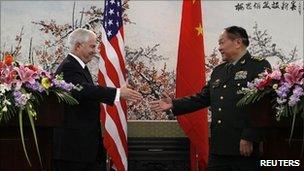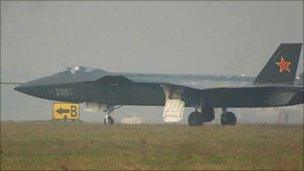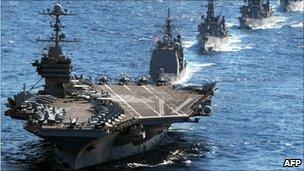Viewpoint: A new Sino-US high-tech arms race?
- Published

Behind the smiles, both sides remain concerned about the other's intentions
Alexander Neill, head of the Asia Security Programme at the Royal United Services Institute, considers the apparent emergence of a new Sino-US high-tech arms race.
Beneath the veneer of official smiles and neatly choreographed handshakes at the defence summit in Beijing, the Sino-US relationship remains fraught with uncertainty.
A year after military relations were frozen by Beijing in the wake of a $6.4bn (£4.1bn) arms package to Taiwan, the US request for a resumption of a substantial strategic dialogue has been given a lukewarm reception in Beijing.
The People's Liberation Army's (PLA) appetite for engagement with the US has waned considerably over the last year.
Cementing its defence arrangement with Taiwan, and holding large-scale naval war games in China's back yard in recent months, the US has buttressed its alliances with its East Asian allies.
These actions have fuelled resentment in China and fears of US military encirclement.
US irritation is based on a recent spate of harassment by the PLA Navy and Chinese fishing vessels against the US Navy and its allies in the West Pacific.
The US is also frustrated with China's intransigence towards meaningful strategic dialogue on international security concerns, particularly while tension on the Korean peninsula remains high and nuclear proliferation by North Korea continues unchecked.
But the Pentagon's visceral concern is its failure to detect the break-neck speed of Chinese military technological advances and its ability to curb an arms race in East Asia.
'Pressure point warfare'
Despite recent headlines reporting the appearance of a Chinese stealth fighter prototype, of more concern to US military planners is the enabling technology that will produce the bite to China's military bark.

Photos of a possible working prototype of a Chinese-made stealth aircraft were recently leaked
This angst is focused on China's decade-long programme of military "informationisation" designed to leap-frog over US capabilities in the Pacific region.
The PLA is rapidly developing asymmetric warfare techniques against US command, control, communications, computers, intelligence, surveillance and reconnaissance infrastructure, known as "C4ISR" in military parlance.
For China, with its inferior conventional military capabilities, the key to gaining the upper hand in a conflict with the US is to gain dominance of the space theatre and to damage its digital nerve system.
China views space as a corner-stone of its future prosperity: a mandate from heaven for China's growth and military strength. For this reason, China is working hard to counter the Pentagon's monopoly in space and to build its own space-based deterrent.
The PLA's doctrine of "pressure point warfare", a multi-layered approach using space, cyberspace and information operations alongside conventional capabilities is designed to cripple an adversary in one swift strike.
This fast paced and high-tech military modernisation has led to the emergence of weapons systems and technology, which in certain theatres has closed the military capability gap with the US considerably.
These include directed energy, jamming and cyber attack technologies, designed to paralyse the US military machine.
The PLA has recently developed and successfully tested advanced anti-satellite (ASAT) weapons systems, demonstrating it can destroy or manoeuvre close to enemy satellites in space. ASAT weapons are part of a new genre of "assassin's mace" or surprise weapons aimed at the Pentagon's Achilles Heel in space and cyberspace.
All of these capabilities require state of the art signals processing and communications systems, technology which China has been developing indigenously to create its own command and control architecture.
Carrier fears
One of the most pressing concerns for the United States navy is the prospect of US aircraft carriers and other vessels being denied access to theatres of operation in the event that the US were dragged into a conflict over Taiwan or in support of its other Pacific allies.

Could Chinese missile systems target US aircraft carriers in the region?
Coined by Pentagon planners as China's "A2/AD" (Anti Access/Area Denial) strategy, the PLA would attempt to prevent US aircraft carriers from deploying to theatre, targeted by Chinese torpedoes, Cruise Missiles and Anti Ship Ballistic Missiles (ASBMs).
PLA tacticians know that a successful strike against a moving US aircraft carrier requires advanced space-based targeting assets and an ability to penetrate the US ballistic missile defence umbrella. They also know that their land-based missiles are vulnerable to attack from the US.
One solution is to develop a submarine-launched ballistic missile (SLBM) capability, something which is also causing for concern for US defence secretary Robert Gates.
The PLA's latest weapons systems serve as an opportunity to showcase China's considerable achievements and provide an anchor for the legitimacy of the Chinese Communist Party.
What the PLA is prepared to reveal in public is also directed at the domestic audience as much as abroad - hence the roll-out of the J-20 stealth fighter prototype and the likely launch of an aircraft carrier within a year or two.
China, Taiwan and the United States do not want a confrontation; this would likely be a disaster of global proportions.
However, as China's President Hu Jintao and his US counterpart Barack Obama prepare to meet next week, the potential for miscalculation and an East Asian arms race extending into the space domain creates a lingering atmosphere of uncertainty and mistrust in the region.

- Published7 January 2011
- Published6 January 2011
- Published17 December 2010
- Published7 November 2010
- Published17 August 2010